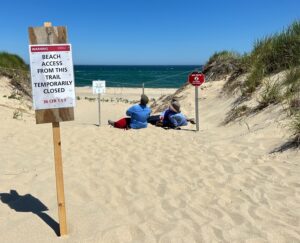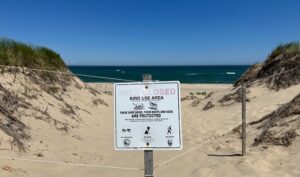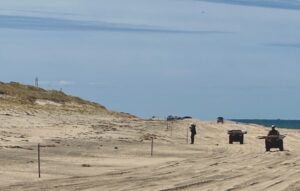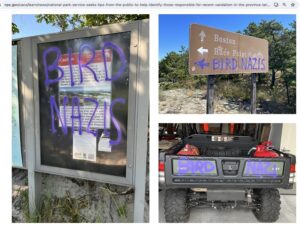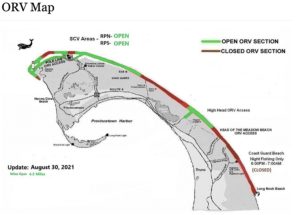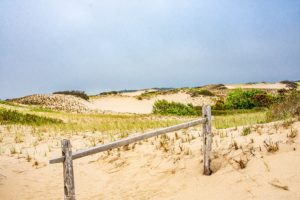In the golden evening light at Race Point Beach, an audience assembled on towels and blankets. Nearby, a group of dancers in white swayed gently back and forth, stretching and bending like seagrass in the wind. Then the music started from a speaker nestled in the sand — a twinkling, eerie duet between violin and mixed percussion. The dancers, around 15 Outer Cape locals ranging from young adults to older people, stepped onto their makeshift stage of smoothed sand.
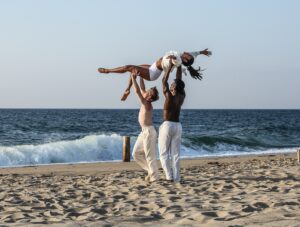
The June 20 performance was part of a community dance project, “Erosions,” led by modern dancer and choreographer Michael Spencer Phillips and his husband, architectural designer Dino Kiratzidis. The couple co-founded their company, Site-Specific Dances, in 2023 and have been creating land-inspired dance projects since 2020.
Friday’s beach performance was in seven parts. It began and ended with dances by community members who had participated in free dance workshops that Phillips led from June 5 to 16 in Provincetown and Wellfleet. Andrew Van Allen, Lloyd Knight, and Deepa Liegel — young New York City dance professionals — danced in the central parts of the performance. Each section corresponded to a movement of the “Erosions Etudes,” a piece composed for the project by Steven Sametz and recorded by brothers Domenic and Miles Salerni on violin and percussion.
“Erosions” has two meanings, says Phillips. “One is the erosion of the land itself. The other is community erosion. How has Provincetown changed? Where is it going?”
Phillips did research for the project over the past year, traveling to Provincetown almost every month and attending concerts, poetry readings, and art shows. “I tried to meet as many people as I possibly could,” he says. He recorded interviews with people talking about their memories of Provincetown and about politics, civil rights, and environmental erosion.
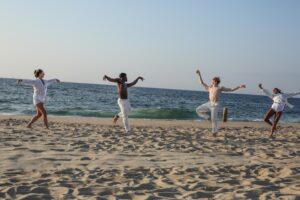
Soundbites from those interviews served as prompts for improvisatory movement in the workshops he led this past month, including one at the Provincetown Inn that concluded with a procession on the West End Breakwater and a children’s workshop at Rainbow Weavers in Wellfleet.
In one interview, Phillips says, he asked for his subject’s fondest Provincetown memory. The response was a story of swimming naked for the first time at Herring Cove. In a workshop, Phillips played this clip. Then he asked participants to think about the first time they felt liberated. “How did your body feel when you felt free and proud of who you were — whether that was on a dance floor, at a Pride event, or swimming naked?” Another prompt addressed the environment: “What does it look like when something erodes? Does it go from high to low? From side to side?”
The group choreography displayed at Race Point originated in these workshops, Phillips says. “We’d pull one movement from this person and one movement from that person. Then we’d string them together into a phrase of movement.”
Phillips, who grew up in Traverse City and Ann Arbor, Mich., reluctantly started dance lessons at 11. “Now it’s become one of the greatest loves of my life,” he says. Since moving to New York City in 1999, he’s worked with dancers and choreographers Merce Cunningham, Robert Battle, and Pascal Rioult. Phillips has spent shoulder seasons here since 2013. “I like the quiet parts of Provincetown,” he says.
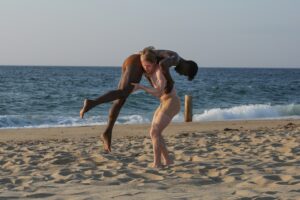
As a choreographer, Phillips carefully considers the settings of his dances. He thinks of the landscape as a “protagonist,” he says. Last year, when he was biking through the Province Lands, he suddenly rounded a bend to a vision of sprawling dunes and ocean. “I thought, this is a place I’d love to make a dance,” he says. “We’re drawn to places that have theatrical potential in the topography and the light. We’re also drawn to places that have social and environmental root systems.” Provincetown had it all.
Race Point Beach was much more than a passive stage in the performance. It played a role. Clothes ruffled in the wind as the dancers moved as one, sweeping the sand with their feet and stroking their arms as if bathing in the ocean. When Van Allen, Knight, and Liegel took the stage as a trio, the audience watched raptly. To a serene, beautiful etude, the three seemed to echo the movements of a gently rolling ocean. Then, to a spritely, almost comical etude, the dancers hopped and twitched like hermit crabs. Provincetown dancer Alexandra Copp, who owns Rainbow Weavers, joined the professionals in an exuberant quartet.
In one short section, Van Allen and Knight danced a sensual and heartbreaking duet in which they embraced and fell apart over and over again. In the ocean behind the stage, four seals swam by, then stopped as if transfixed.
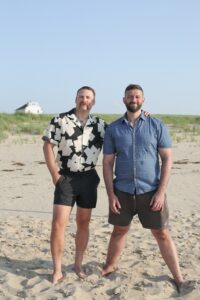
Despite its sense of finality, the Race Point performance was not the culmination of “Erosions” but a component of a something bigger. Every part of the project so far — the interviews, workshops, and performances — have been filmed by Site-Specific’s videographer Emma Kazaryan and will be compiled in a documentary that Phillips hopes to bring to Provincetown next summer.
In the final section of the Race Point show, community members and professionals held the stage together. At each of Phillips’s workshops, participants had learned the same movement: Like a field of kelp being moved by the sea, the dancers reached up, then down. They twisted, bent, and circled each other. When they took their bows, a spell seemed to break, and the audience’s silence became enthusiastic cheers.
“Everyone can dance,” says Phillips. “Everyone can create movement. We stick to that, and it always works out.”
